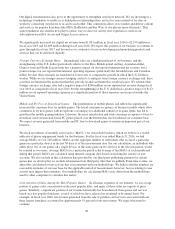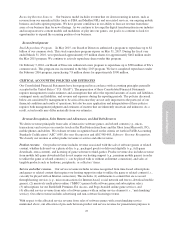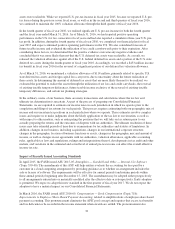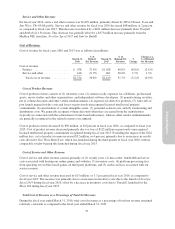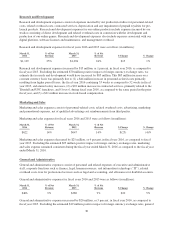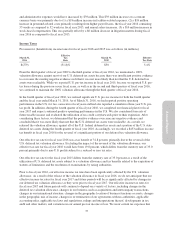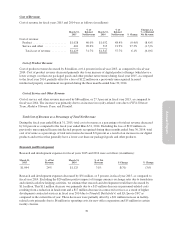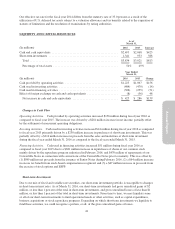Electronic Arts 2016 Annual Report Download - page 117
Download and view the complete annual report
Please find page 117 of the 2016 Electronic Arts annual report below. You can navigate through the pages in the report by either clicking on the pages listed below, or by using the keyword search tool below to find specific information within the annual report.
Annual Report
the timing of the title’s release and competition, and (4) future pricing. Determining the effective royalty rate for
our titles is particularly challenging due to the inherent difficulty in predicting the popularity of entertainment
products. Furthermore, if we conclude that we are unable to make a reasonably reliable forecast of projected net
revenue, we recognize royalty expense at the greater of contract rate or on a straight-line basis over the term of
the contract. Accordingly, if our future revenue projections change, our effective royalty rates would change,
which could impact the amount and timing of royalty expense we recognize.
Prepayments made to thinly capitalized independent software developers and co-publishing affiliates are
generally made in connection with the development of a particular product, and therefore, we are generally
subject to development risk prior to the release of the product. Accordingly, payments that are due prior to
completion of a product are generally expensed to research and development over the development period as the
services are incurred. Payments due after completion of the product (primarily royalty-based in nature) are
generally expensed as cost of revenue.
Our contracts with some licensors include minimum guaranteed royalty payments, which are initially recorded as
an asset and as a liability at the contractual amount when no performance remains with the licensor. When
performance remains with the licensor, we record guarantee payments as an asset when actually paid and as a
liability when incurred, rather than recording the asset and liability upon execution of the contract. Royalty
liabilities are classified as current liabilities to the extent such royalty payments are contractually due within the
next 12 months.
Each quarter, we also evaluate the expected future realization of our royalty-based assets, as well as any
unrecognized minimum commitments not yet paid to determine amounts we deem unlikely to be realized through
product and service sales. Any impairments or losses determined before the launch of a product are generally
charged to research and development expense. Impairments or losses determined post-launch are charged to cost
of revenue. We evaluate long-lived royalty-based assets for impairment using undiscounted cash flows when
impairment indicators exist. If impairment exists, then the assets are written down to fair value. Unrecognized
minimum royalty-based commitments are accounted for as executory contracts, and therefore, any losses on
these commitments are recognized when the underlying intellectual property is abandoned (i.e., cease use) or the
contractual rights to use the intellectual property are terminated.
Income Taxes
We recognize deferred tax assets and liabilities for both (1) the expected impact of differences between the
financial statement amount and the tax basis of assets and liabilities and (2) the expected future tax benefit to be
derived from tax losses and tax credit carryforwards. We record a valuation allowance against deferred tax assets
when it is considered more likely than not that all or a portion of our deferred tax assets will not be realized. In
making this determination, we are required to give significant weight to evidence that can be objectively verified.
It is generally difficult to conclude that a valuation allowance is not needed when there is significant negative
evidence, such as cumulative losses in recent years. Forecasts of future taxable income are considered to be less
objective than past results. Therefore, cumulative losses weigh heavily in the overall assessment.
In addition to considering forecasts of future taxable income, we are also required to evaluate and quantify other
possible sources of taxable income in order to assess the realization of our deferred tax assets, namely the
reversal of existing deferred tax liabilities, the carry back of losses and credits as allowed under current tax law,
and the implementation of tax planning strategies. Evaluating and quantifying these amounts involves significant
judgments. Each source of income must be evaluated based on all positive and negative evidence; this evaluation
involves assumptions about future activity. Certain taxable temporary differences that are not expected to reverse
during the carry forward periods permitted by tax law cannot be considered as a source of future taxable income
that may be available to realize the benefit of deferred tax assets.
From the third quarter of fiscal year 2009 to the third quarter of fiscal year 2016, we maintained a 100%
valuation allowance against most of our U.S. deferred tax assets because there was insufficient positive evidence
to overcome the existing negative evidence such that it was not more likely than not that the U.S. deferred tax
31







